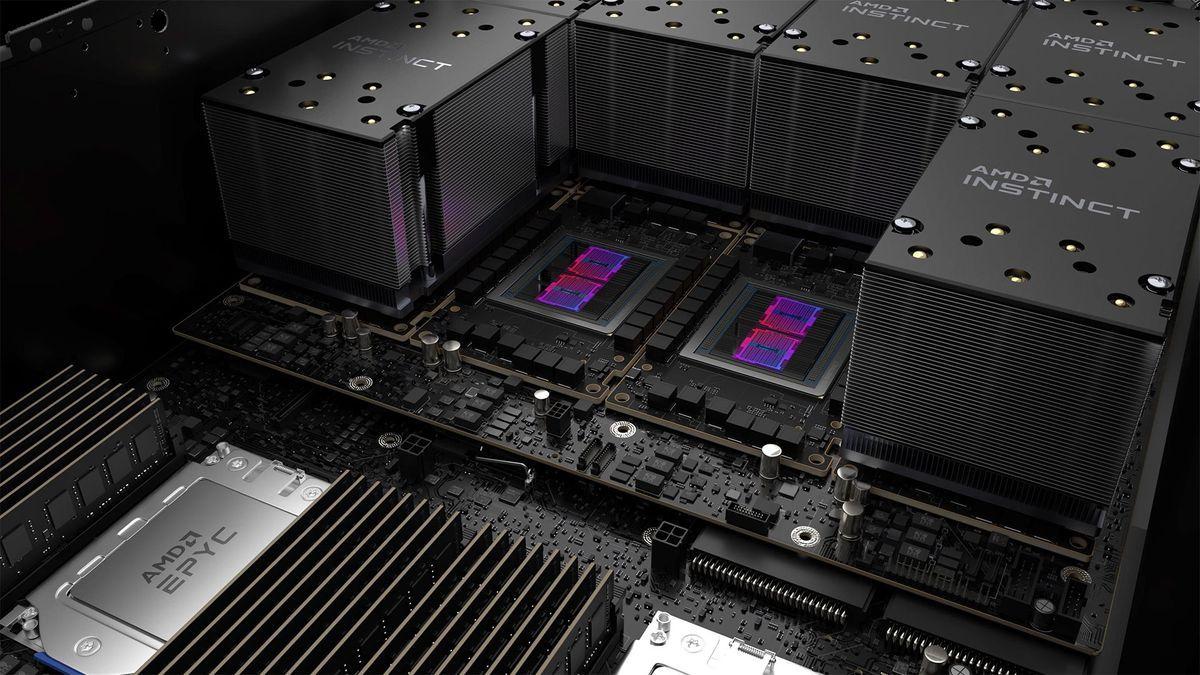AMD Dominates Top500 Supercomputer Rankings with El Capitan and Frontier
2 Sources
2 Sources
[1]
AMD supercomputers take gold and silver in latest Top500 as Chinese HPC remains shrouded in secrecy
China stays mum regarding the performance of its latest supercomputing installations. Top500.org on Tuesday released its 65th list of the world's most powerful supercomputers, revealing the dominance of American AMD-based systems amid a lack of new entries from China, as well as the performance of supercomputers used by AI giants such as xAI and OpenAI. The latest update to the global high-performance computing rankings places the AMD Instinct MI300A-based El Capitan at the forefront with Rmax performance of 1.7 FP64 ExaFLOPS, followed by the AMD-powered Frontier (1.353 ExaFLOPS) and Intel-based Aurora (1.012 ExaFLOPS) as the top three exascale-class systems, all of which are operated by U.S. Department of Energy laboratories. The world's fourth-most most powerful supercomputer -- Germany's Jupiter Booster, based on Nvidia's GH200 platform -- is a new entrant offering Rmax performance of 0.793 ExaFLOPS. Rounding out the top five, Microsoft's Eagle achieved 0.561 ExaFLOPS. El Capitan, located at Lawrence Livermore National Laboratory in California, achieves 1.742 ExaFLOPS on the HPL benchmark using AMD's fourth-generation EPYC processors and Instinct MI300A accelerators, all within an HPE Cray EX255a framework. It comprises over 11 million cores and uses the HPE Slingshot interconnect. El Capitan also topped the companion High Performance Conjugate Gradients (HPCG) performance list with 17.1 PetaFLOPS and in the HPL-MxP mixed-precision benchmark with 16.7 ExaFLOPS. As for energy efficiency, it stands at 58.9 GigaFLOPS per watt. Frontier, the second-place system in HPL, is installed at Oak Ridge National Laboratory in Tennessee and achieved 1.353 ExaFLOPS. It uses AMD's third-generation EPYC CPUs, Radeon Instinct 250X accelerators, and HPE Cray EX235a infrastructure with the same Slingshot interconnect. It operates with over 8.6 million cores. Frontier ranks third in the HPCG benchmark (behind Japan's Fugaku) with 14.05 petaflops. Frontier also took third place in the HPL-MxP benchmark with 11.4 ExaFLOPS. Its energy efficiency works out to 54.98 GigaFLOPS per watt. Aurora is housed at Argonne National Laboratory in Illinois and recorded 1.012 ExaFLOPS on the HPL benchmark for the bronze medal in HPL. Built on Intel Xeon CPU Max and Data Center GPU Max (aka Ponte Vecchio) components, it relies on an HPE Cray EX installation using the Slingshot interconnect. It secured the second spot in the HPL-MxP benchmark with 11.6 ExaFLOPS, but it's in fourth place on the HPCG benchmark at 5.6 PFLOPS. JUPITER Booster is Europe's first system in this performance class. The machine is installed at the Jülich Supercomputing Centre in Germany and reaches its fourth-place spot with a preliminary 793.4 PFLOPS in HPL. JUPITER Booster uses Nvidia Grace Hopper hardware on Eviden's BullSequana XH3000 platform with direct liquid cooling and HP's Slingshot networking. It is currently being brought online. Microsoft Azure's Eagle system holds the fifth position in HPL with 561 PFLOPS using Xeon Platinum 8480C processors and Nvidia H100 GPUs. Although CPUs from AMD power two of the world's highest-performing processors and five out of Top 10 machines, a detailed analysis of the June 2025 Top 500 list reveals that Intel processors are used in 294 of the 500 systems. AMD follows with 173 supercomputers. Nvidia systems appear in 13 entries, showing early traction for the Arm-compatible Grace Hopper architecture. Nine systems are based on other Arm processors, such as Fujitsu's A64FX. An additional six systems use other processor types, including IBM Power9 and China's Sunway architecture. The U.S. extended its numerical lead in total systems in the 65th list, while China continued its downward trend as it no longer submits results of its latest systems to Top500.org. As a result, there are 175 American systems, 47 Chinese supercomputers, and 41 German machines in the Top 500 list. On the energy efficiency front, Germany's JEDI system leads with 72.73 GigaFLOPS per watt, followed by France's ROMEO-2025 at 70.91 and Adastra 2 at 69.1. All three use BullSequana XH3000 infrastructure. El Capitan and Frontier ranked 26th and below on energy, reflecting a different balance between performance and efficiency.
[2]
AMD-Powered El Capitan and Frontier Lead the Top500 Supercomputer Rankings
"From El Capitan to Frontier, AMD continues to power the world's most advanced supercomputers, delivering record-breaking performance and leadership energy efficiency," said Forrest Norrod, executive vice president and general manager, Data Center Solutions Group, AMD. "With the latest Top500 list, AMD not only holds the top two spots but now powers 172 of the world's fastest systems -- more than ever before -- underscoring our accelerating momentum and the trust HPC leaders place in our CPUs and GPUs to drive scientific discovery and AI innovation."
Share
Share
Copy Link
AMD-powered supercomputers El Capitan and Frontier secure the top two positions in the latest Top500 list, showcasing the company's growing influence in high-performance computing.
AMD Takes the Lead in Supercomputing
The latest Top500 list of the world's most powerful supercomputers has been released, showcasing AMD's dominance in the high-performance computing (HPC) sector. The AMD Instinct MI300A-based El Capitan has claimed the top spot with an impressive Rmax performance of 1.7 FP64 ExaFLOPS, followed closely by the AMD-powered Frontier at 1.353 ExaFLOPS
1
.El Capitan: A Technological Marvel

Source: Tom's Hardware
Located at Lawrence Livermore National Laboratory in California, El Capitan achieves its record-breaking performance using AMD's fourth-generation EPYC processors and Instinct MI300A accelerators. The system comprises over 11 million cores and utilizes the HPE Slingshot interconnect within an HPE Cray EX255a framework
1
.Frontier: A Close Second
Frontier, installed at Oak Ridge National Laboratory in Tennessee, secures the second position with 1.353 ExaFLOPS. It employs AMD's third-generation EPYC CPUs and Radeon Instinct 250X accelerators, operating with over 8.6 million cores
1
.Global Supercomputing Landscape
The United States has extended its lead in the total number of systems on the Top500 list, with 175 American supercomputers represented. Germany follows with 41 systems, while China's participation continues to decline, with only 47 systems listed
1
.AMD's Growing Influence
AMD's presence in the supercomputing world has significantly increased, now powering 172 of the world's fastest systems. This growth underscores the company's accelerating momentum and the trust placed in their CPUs and GPUs by HPC leaders
2
.Related Stories
Energy Efficiency Considerations
While AMD-powered systems dominate in performance, they face challenges in energy efficiency. Germany's JEDI system leads in this aspect with 72.73 GigaFLOPS per watt, followed by France's ROMEO-2025 and Adastra 2. El Capitan and Frontier rank 26th and below in energy efficiency, highlighting a different balance between performance and power consumption
1
.Implications for Scientific Discovery and AI Innovation
The advancements in supercomputing power, particularly those driven by AMD, have significant implications for scientific discovery and AI innovation. Forrest Norrod, executive vice president at AMD, emphasized the company's role in powering the world's most advanced supercomputers and their commitment to driving progress in these critical areas
2
.References
Summarized by
Navi
[1]
Related Stories
AMD Powers El Capitan: World's Fastest Supercomputer Breaks Exascale Barrier
19 Nov 2024•Technology

AMD and DOE Forge $1 Billion Partnership for Sovereign AI Supercomputers
27 Oct 2025•Science and Research

AMD's Ambitious 20x30 AI Efficiency Goal: Embracing Rack-Scale Architecture and Power Constraints
13 Jun 2025•Technology

Recent Highlights
1
Google launches Gemini 3 Flash as default AI model, delivering speed with Pro-grade reasoning
Technology

2
OpenAI launches ChatGPT app store, opening doors for third-party developers to build AI-powered apps
Technology

3
OpenAI launches GPT Image 1.5 as AI image generator war with Google intensifies
Technology





